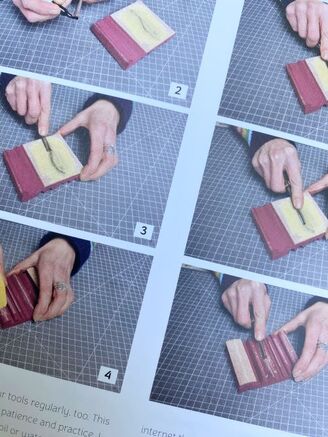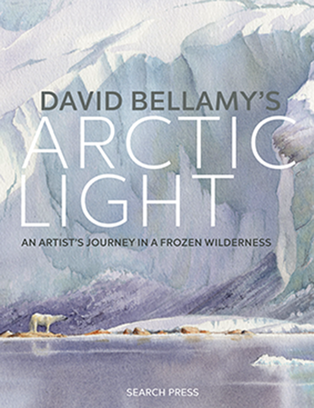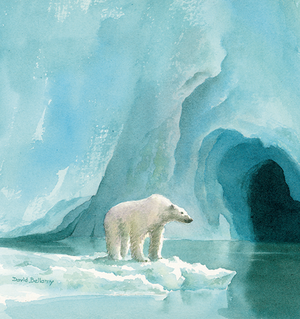|
Linocut – A Creative Guide to Making Beautiful Prints Sam Marshall Published by Herbert Press ISBN 978-1-7899-4070-1 Price £20 This book by Sam Marshall is a comprehensive guide to Lino Cutting and Printing. I’ve had this book for a while and wanted to really absorb it before reviewing it. I’ve read it several times and it is a fantastic tool for learning about this art from beginner level to advanced. I have done some lino cutting previous to this and my practice has mainly been confined to motifs and patterns. Reading this book has been an inspiration to me of how much further I can take this and has made me feel confident that with these instructions, I can do so much more. Sam Marshall is a printmaker and teacher with a passion for what she does. It comes through the pages and infects you with an enthusiasm to try the exercises out. I didn’t realise that the kind of work seen by other printmakers was something that we are all capable of if we give ourselves a chance. Sam takes us through all the basics, from the different types of tools and inks to sharpening your tools. Reading about the papers, ways of registering prints, cleaning up and printing gives you a good foundation for getting started. I learned things that were probably holding me back from taking the plunge and they were all set out in an easy and straightforward manner. In getting started, you learn about cutting the blocks in different ways in order to see what type of prints you want. This will help you understand what you want to achieve and how you are going to approach the drawing and cutting. Once you have that in mind, you go on to learn about different ways of printing, including reduction printing which I always though sounded too complicated to try. Everything you need is in there and there are exercises to help you think about what your pieces will look like (for example, spending an hour in the garden, observing and sketching). I came away with more confidence to look again at photos of plants and flowers and think about how I could translate them into lino plates. There are many examples of Sam’s beautiful prints in the book to inspire you and I was thoroughly inspired to look at sun, sky, sea and nature in a more graphic way. This is a book that contains all the information to draw and print in the way that you see the world. I love this book and intend to use it to guide me on a trip down the inky road of artistic endeavours. Here are some of my endeavours since reading the book:
0 Comments
David Bellamy’s Arctic Light An Artist’s Journey in a Frozen Wilderness Published by Search Press www.searchpress.com ISBN 978-1-78221-423-6 Price £25.00/ $35.00 Available from www.searchpress.com David Bellamy is a watercolour artist, author of several books, teacher and, as it turns out, quite an adventurer. Having travelled previously to the Himalayas, Andes and Africa, chillier climes are sought out here.  David recounts this expedition where he travelled to the Scandinavian Arctic in Greenland and Svalbard into Norway and Iceland. For those that read his account of what he saw, did and painted, this book is a perfect way of living life vicariously through the artist. David’s experiences are hilarious, breathtaking and terrifying in equal measure. He balances each out perfectly, taking you from humour to the grim reality of the cold, the danger and physical injuries. His descriptions of the environs are rich with imagery such as the ‘lava-black Icelandic moonscape, surrounded by blackened and distorted lava-demons, statuesque and eerie in the mist’ and poetic: ‘I peered…into light that transformed them into many-coloured jewels, sparkling where sunlight caught sharp edges, incandescent with breathtaking purity’. With descriptions like these, you also travel on a journey lit up by his words. It is a book of many different experiences of people, places and animals and all are reflected in the beautiful artwork that David Bellamy produces. Many sketches were produced under freezing conditions and it is fascinating to see pictures that were sketched whilst he was hanging from an icy crevasse or paintings where the colour froze as it was applied. Just flicking through to look at each of the pictures in turn, you can only guess the sense of wonder at seeing these places first hand when their interpretations are things of beauty.
This is a book of many things and each sitting brings something new to the reader. An insight into the way of life for the people that live and work in the places David Bellamy has visited, the harshness of life but also a travelogue of one man’s experiences seeing polar bears, walruses, glaciers, volcanos and icebergs. Entertaining, informative and a thing of beauty. What more could we ask for? Colour Mixing Guide
Watercolour Julie Collins ISBN 978-1-78221-054-2 Published by Search Press www.searchpress.com Price £6.99 There are many books available on Colour Theory (some of which we have reviewed in WOW, such as Ruth Issett’s Passion for Colour, or Joen Wolfrom’s Color Play), and some people make it their life’s work exploring colour theory. However, I particularly like Julie Collins’s book, because it takes you right back to the beginning and takes a very simple approach. It deals with watercolour paints, but actually, it doesn’t really matter about the medium when you are getting started with learning about the colour wheel and what you can do with the basics. I took this book on holiday. It is small, light, and doesn’t take up too much room. I didn’t use the paints and colours that were set out here, but instead took some Koh-i-noor Dye paints and the Koh-i-Noor Watercolour Wheel. I felt that I could find basic colours on which to start my education in these sets. The colours used in the book are of a limited palette, taking the viewpoint that if you have red, blue and yellow, you can make an infinite number of colours. There are 4-5 of each colour, and these are used to demonstrate different colour combinations. You cover primary, secondary, tertiary and complementary colours, and then look at colour mixes of different combinations of colour amount. Using the book, with the specific colours listed, you have around 400 variations. The swatches are immensely useful for a particular colour you like, as you have a vast visual library for finding and creating a similar colour with the materials you have. I felt that it gave me a great practical grounding for moving onto more adventures in colour, and I think that it would be a good book for anyone to have if you are looking at dyeing fabric or paper and don’t know where to start for combining colours. |
Proudly powered by Weebly














 RSS Feed
RSS Feed